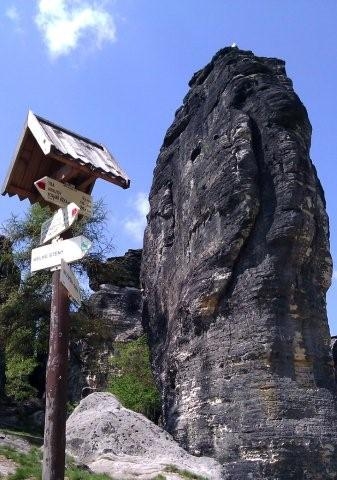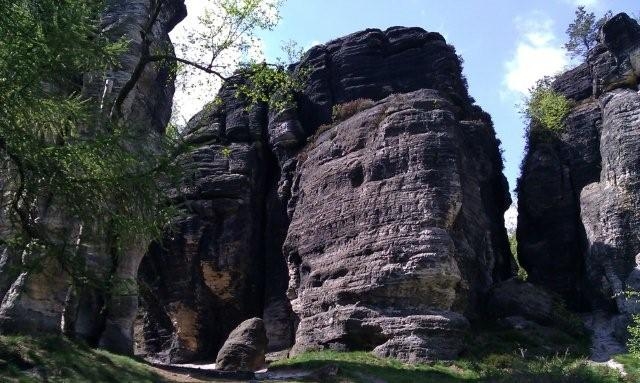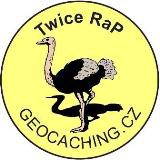
Geologie Tiských sten/Geology of Tisa walls
Tiské steny
Tiské steny patrí k nejkrásnejším skalním mestum v Ceské republice. Bohatstvím skalních útvaru je toto území srovnatelné se známými národními parky v USA (Arizona, Utah). Urcite byste ho meli navštívit. Do Tiských sten a na souradnice této Earthky Vás privede cervená turistická znacka vedoucí z centra obce Tisá nacházející se v blízkosti kostela sv.Anny nedaleko doporuceného parkovacího waypointu.

Geologický vývoj Tiských sten
Geologická historie Tiských sten zacíná zhruba pred sto miliony let v druhohorách, kdy se z píscitých usazenin svrchnokrídového more vytvorilo až nekolik set metru mocné souvrství. Zpevnením techto píscitých sedimentu vznikly pískovce. More ustoupilo a ve tretihorách bylo pískovcové souvrství rozlámáno soustavou zlomu, probíhající v blízkém Ceském stredohorí. Pískovce i se svým krystalickým podložím byly pritom vyzdviženy a ukloneny k severu. Tím byly vystaveny zvetrávání, které behem ctvrtohor vymodelovalo jejich soucasnou podobu. Práve zvetrávání bude venována tato Earthcache. Další podrobnosti geologického vývoje Tiských sten a celého Labského pískovce si mužete precíst v Earthce Ostrovské skály.
Zvetrávání hornin
Zvetrávání je oznacení pro proces, pri kterém dochází k pusobení chemických, fyzikálních, ci biologických sil na obnažené horniny. Zvetrávání muže v prubehu miliónu let vést k rozpadu hornin a následné erozi, které vedou k celkovému pretvorení tváre krajiny. Rychlost zvetrávání závisí na složení horniny, na klimatických podmínkách atd.
Zvetrávání mužeme rozdelit podle prevládajícího typu pusobící síly na:
Fyzikální (mechanické) zvetrávání
Fyzikální zvetrávání je proces, pri kterém dochází k rozpadu hornin, aniž by nastaly výraznejší zmeny v jejich chemickém složení. Jeho prícinou jsou tepelné i objemové zmeny v povrchové vrstve hornin. Jelikož jsou veškeré horniny složeny z ruzné kombinace minerálu, mají všechny horniny urcitou teplotne tlakovou mez, pri které prestávají být stálé a pri které dochází k poruše jejich celistvosti vlivem praskání. Vlivem tektonické cinnosti a následného obnažení hornin dochází k jejich vystavení rozdílným teplotním a tlakovým podmínkám. Postupné ubývání teploty a tlaku vede ke chladnutí hornin, což má za následek jejich smrštování a popraskání, ci rozpukání. Kapalná voda, pronikající do vzniklých puklin, se následne premenuje na led, což má za následek zvetšující se tlak v puklinách a odtrhávání cásti skalního masívu (led má tendenci zvetšovat svuj objem pri prechodu na pevnou fázi, zmena muže dosáhnout až 1/10 objemu). Pravidelné opakování rozmrzání a zamrzání vody v pukline má za následek její zvetšování. Odborne se tento proces nazývá mrazové zvetrávání a je typický pro obnažené vrcholky hor. Druhým duležitým faktorem je pusobení teploty, kdy vlivem ohrívání a chladnutí telesa dochází k jeho smrštování (kontrakci) a roztahování (expanzi), což zpusobuje v extrémních prípadech až roztrhání horniny.
Chemické zvetrávání
Chemické zvetrávání je typ zvetrávání, behem kterého dochází k rozkládání urcitých horninových minerálu a k následnému vytvorení minerálu nových. Chemické zvetrávání je závislé na teplote a vlhkosti. Cím jsou obe veliciny vetší, tím rychleji k zvetrávání dochází. Atmosférická voda reaguje se vzdušným oxidem uhlicitým, což má za následek vznik kyselého roztoku, který rozpouští urcité minerály behem vsakování do pudy. Vznikají krasové oblasti. Další významným reakcním cinidlem je podzemní a morská voda, která má schopnost reagovat s jinými druhy minerálu (slídy, živce mohou reagovat za vzniku jílu a kaolinitu). Další chemické zvetrávání je typické pro horniny obsahující železo, které reagují za vzniku oxidu železitého, jenž je charakteristický svojí nacervenalou barvou.
Biologické zvetrávání
Dalším duležitým faktorem pro zvetrávání jsou živoucí organismy, a to prevážne mikroorganismy, které reagují s horninami, címž vyvolávají jejich biochemický rozklad. Nejcastejší je rozklad lišejníky, rozšírenými po celé Zemi. Lišejníky uvolnují kyselinu, která rozrušuje horniny, což má za následek vznik pud. Vetší organismy se dále podílejí na rozrušování hornin napríklad korenovým systémem, který je schopen se dostat do menších puklinek a následne rozervat skalní masív. Na druhou stranu korenový systém funguje i jako tmel, který zabranuje dalšímu fyzikálnímu rozrušování vlivem teploty a tlaku. Nejduležitejším organismem, ovlivnujícím tvár Zeme, je v posledních stoletích clovek, který je schopen pretváret rozsáhlá území svojí povrchovou i podpovrchovou dulní cinností.
Kombinace zvetrávání
Na Zemi se ve vetšine prípadu setkáváme s tím, že se 3 základní typy zvetrávání navzájem prolínají a že pusobí za vzájemné spoluúcasti a pri vzájemném doplnování. Pro urcité oblasti jsou charakteristické ruzné kombinace zvetrávání, které v dané oblasti vetšinou prevládají a které mají hlavní charakter. Musíme však mít na pameti, že se ve vetšine prípadu nejedná o pusobení v oblasti jediné.
Zvetrávání pískovcových sten
Pri zvetrávání pískovcových sten vzniká na povrchu typický tvar, který bude Vaším úkolem ve skalách najít a vyfotit. Jedná se o proces chemického zvetrávání, kdy na povrchu skály prosakuje vlhkost, která druhotne vylucuje opálové a solné vrstvicky. Opál zpevnuje vyvýšené oválné okraje a soli (zejména sírany) naopak rozrušují stmelená zrnka pískovce a umožnují i rychlejší prohlubování vznikajících dutin. Jedinecný vzhled pískovcových skal je výsledkem dlouhotrvající eroze a výše popsaného chemického zvetrávání.
Pro uznání logu této Earthky musíte splnit následující úkoly :
1) Jak se nazývá typický tvar povrchu pískovcových sten vzniklý predevším chemickým zvetráváním?
2) Na zvetrávání pískovcových skal mel vliv i jejich úklon k severu. Pri jaké cinnosti k vychýlení skal došlo a o kolik stupnu byly skály vychýleny.
3) Kolikrát se v názvech skalních útvaru Tiských sten objevuje slovo slon?
Nepovinný úkol, který nám udelá radost :
Vyfotte se u libovolného pískovcového útvaru Tiských sten a fotografii priložte i s názvem skalního útvaru ke svému logu.
Odpovedi zasílejte pres náš profil nebo na e-mail twicerap@volny.cz . Logujte ihned, necekejte na schválení odpovedí. V prípade nejasností Vás budeme kontaktovat.
********************************
English :
The Tisa walls
Tisa walls is one of the most beautiful rocks cities in the Czech Republic. Wealth of rock formations this area is comparable to the famous parks in USA (like ARIZONA, UTAH). You would have to visit it. How do you get there? Go to the park waypoint which is not far from a church of St. Anna. The church is situated in the centre of village Tisá. You have to find the red tourist trail near church. You can go according to the red tourist trail from the center of Tisa to the starting coordinates.


Geology of The Tisa walls
Tisa geological history of the walls starting about a hundred million years in the Mesozoic Era, when the Cretaceous sea sand deposits created several hundred meters thick layers. Hardening of sandy sediments formed sandstone. The sea receded and in the Tertiary sandstone formations were breaking. Sandstones with his crystalline bedrock yet been lifted and inclined a few degrees to the north. It was built of weathering, which during the Quaternary modeled their current form. It will be devoted to these weathering Earthcache. Further details of the geological development of the Tisa Elbe sandstone wall can be read in Eartcache Ostrovské skály.
Weathering
Weathering is the term for the process is experiencing the effects of chemical, physical, and biological forces on bare rock. Weathering can over millions of years lead to the disintegration of rock and subsequent erosion, leading to an overall transformation of the landscape. Weathering rate depends on the composition of rocks, the climatic conditions, etc.
Physical weathering
Physical weathering is the class of processes that causes the disintegration of rocks without chemical change. The primary process in physical weathering is abrasion (the process by which clasts and other particles are reduced in size). Physical weathering includes predominantly thermal stress weathering and frost weathering. Thermal stress weathering is results from expansion or contraction of rock, caused by temperature changes. Frost weathering, frost wedging, ice wedging or cryofracturing is the collective name for several processes where ice is present. This processes include frost shattering, frost-wedging and freeze-thaw weathering. This type of weathering is common in mountain areas where the temperature is around the freezing point of water.
Chemical weathering
Chemical weathering changes the composition of rocks, often transforming them when water interacts with minerals to create various chemical reactions. Chemical weathering is a gradual and ongoing process as the mineralogy of the rock adjusts to the near surface environment.
Biological weathering
A number of plants and animals may create chemical weathering through release of acidic compounds, i.e. moss on roofs is classed as weathering. Mineral weathering can also be initiated and/or accelerated by soil microorganisms.
The combination of weathering
On Earth, in most cases we see that the three basic types of weathering mingle and acts for the mutual participation and mutual complementarity. For certain areas are characterized by different combinations of weathering, which usually dominate the area and have the main character. But we must bear in mind that in most cases not a single action in the field.
Weathering of sandstone wall
The weathering of the sandstone walls on the surface there is a typical shape that will be your task to find the rocks and take pictures. It is a a process of chemical weathering ,the rocks on the surface of seepage , which excludes the sub-salt layers, and opal . Opal firms raised oval border and salts (particularly sulphates), however, disturbed cemented sandstone grains and allow for faster deepening of emerging cavities. The unique look of sandstone is the result of long-term erosion and chemical weathering described above.
For the recognition of the log you must fulfill the following tasks:
1) What is called the characteristic shape of the surface of the sandstone walls in particular from chemical weathering?
2) Weathering of sandstone rocks influenced their inclination to the north. How to deflect the rocks were and how many degrees were skewed rock?
3) How many times in the names of rock formations Tisa walls appear elephant?
Optional task, that will make us happy:
Select the sandstone formation and take a picture of it. The picture send us via e-mail.
Send us your answers via e-mail twicerap@volny.cz or our profile.

Deutsch :
Die Tyssaer Wände
Die Tyssaer Wände gehören zu den schönsten Felsenstädten in der Tschechischen Republik. Dem Reichtum ihrer Felsenformen nach ist diese Gegend vergleichbar mit den berühmten Nationalparks in den USA (wie Arizona, Utah). Diesen Ort sollten Sie in jedem Fall besuchen!
Wie gelangt man dorthin? Gehen Sie zum Parkwegpunkt, der nicht weit von der Kirche St. Anna entfernt ist. Die Kirche befindet sich in der Mitte des Dorfes Tisá. Von dort aus müssen Sie den roten Wanderweg in der Nähe der Kirche finden. Sie können an Hand der roten Markierung vom Zentrum Tisas zu den Startkoordinaten gelangen.
Die geologische Geschichte der Tyssaer Wände beginnt vor etwa 100.000.000 Jahren im Mesozoikum, zu der Zeit als Meersandablagerungen der Kreidezeit mehrere hundert Meter dicke Schichten erzeugten. Durch das Erhärten von Sandsedimenten wurde Sandstein gebildet. Das Meer wich zurück und im Tertiär wurden die Sandsteinformationen gebrochen. Dabei wurden die Sandsteine ??mit ihrem kristallinen Unterbau angehoben und um ein paar Grad nach Norden geneigt. Der Verwitterung preisgegeben wurden die Sandsteinformationen während des Quartärs zu ihrer derzeitigen Form modelliert. Der Verwitterung wird dieses Earthcache gewidmet sein. Weitere Einzelheiten der geologischen Entwicklung der Tyssaer Elbsandsteinwände können im Earthcache „Ostrovské skály“ nachgelesen werden.
Verwitterung
Verwitterung ist die Bezeichnung für den Prozess, bei welchem chemische, physikalische und biologische Kräfte auf das Gestein einwirken. Verwitterung kann über Millionen von Jahren zum Zerfall der Felsen und zu anschließender Erosion führen, was eine allgemeine Umgestaltung der Landschaft nach sich zieht. Verwitterung ist abhängig von der Zusammensetzung der Gesteine, den klimatischen Bedingungen, etc.
Die physikalische Verwitterung
Die physikalische Verwitterung bezeichnet diejenige Art von Prozessen, die den Zerfall der Felsen ohne chemische Veränderung bewirkt. Die Ursache der physikalischen Verwitterung ist vorwiegend thermisch beeinflusste Witterung und Frostverwitterung. Thermische beeinflusste Verwitterung ist das Ergebnis von Expansion oder Kontraktion des Felsen, durch Temperaturschwankungen verursacht. Frostverwitterung, Frostsprengung oder Eisverkeilen ist der Sammelbegriff für verschiedene Prozesse, bei denen Eis vorhanden ist. Diese Art der Verwitterung ist in Berggebieten verbreitet, wo sich die Temperatur um den Gefrierpunkt des Wassers bewegt.
Chemische Verwitterung
Chemische Verwitterung verändert die Zusammensetzung von Gesteinen, oftmals dadurch, dass Wasser in Wechselwirkung mit Mineralien verschiedene chemische Reaktionen erzeugt. Chemische Verwitterung ist ein schrittweiser und kontinuierlicher Prozess, bei welchem sich die Mineralogie des Felsens an die Umwelt anpasst.
Biologische Verwitterung
Eine Reihe von Pflanzen und Tieren können chemische Verwitterung durch Freisetzung von sauren Verbindungen schaffen, so wird z.B. Moos auf Dächern als Verwitterung eingestuft. Mineralische Verwitterung kann auch ausgelöst und / oder beschleunigt werden durch Mikroorganismen im Boden.
Die Kombination von Verwitterung
Auf der Erde, in den meisten Fällen sehen wir, dass die drei Grundtypen von Verwitterung in Kombination vorkommen.
Verwitterung von Sandsteinwänden
Bei der Verwitterung der Sandsteinwände entsteht auf der Oberfläche eine typische Form, die Sie in den Felsen finden und fotografieren sollen. Hier handelt es sich um einen Prozess der chemischen Verwitterung, bei dem auf der Oberfläche der Felsen Feuchtigkeit eindringt, das die Salz- und Opalschichten absondert. Opal stärkt den erhöhten Rand des Ovals und die Salze (vor allem Sulfate) zerstören wiederum die zementierten Sandsteinkörner und ermöglichen eine noch schnellere Vertiefung der entstehenden Hohlräume. Das einzigartige Aussehen der Sandsteinfelsen ist das Ergebnis einer langfristigen Erosion und chemischen Verwitterung wie oben beschrieben.
Für die Anerkennung des Logos müssen Sie folgende Aufgaben erfüllen:
1) Wie wird die charakteristische Oberflächenform der Sandsteinwände, die insbesondere durch chemische Verwitterung entsteht, genannt?
2) Einfluss auf die Verwitterung von Sandsteinfelsen hat auch ihre Neigung nach Norden. Wodurch kam es zu dieser Neigung und um wieviel Grad sind die Sandsteinfelsen geneigt?
3) Wie oft finden wir in den Namen der Felsformationen der Tyssaer Wände das Wort Elefant?
Freiwillige Aufgabe, worüber wir uns freuen würden:
Lassen Sie sich bei einer Sandsteinformation fotografieren und schicken Sie uns dieses Bild per e-mail.
Ihre Antworten senden Sie an twicerap@volny.cz oder an unser Profil.
Za preklad do nemciny velice dekujeme manželum Kašlíkovým.
